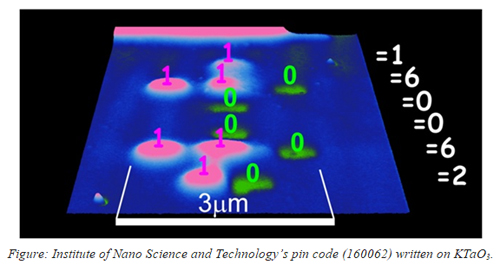 Scientists from the Institute of Nano Science & Technology (INST), an autonomous institute of Department of Science and Technology, Government of India, showed the possibilities of utilizing oxide surface and interface for volatile as well as non-volatile electronic memory devices at room temperature.
Scientists from the Institute of Nano Science & Technology (INST), an autonomous institute of Department of Science and Technology, Government of India, showed the possibilities of utilizing oxide surface and interface for volatile as well as non-volatile electronic memory devices at room temperature.
The major part of the present electronics devices are governed by Silicon technology. Oxide materials exhibit almost all possible emergent physical properties such as superconductivity, ferroelectricity, magnetism, and so on. In spite of that, oxides are still lagging behind in the race of electronics materials. Oxide materials with different exotic physical properties can be combined together in the form of ‘thin film superlattices’ to realize new or integrated physical properties that could be useful for future generation spin-electronics devices.
Dr. Suvankar Chakraverty’s group stored a non-volatile data density around 100GB on the conducing surface of KTaO3 using a regular laboratory-based atomic force microscopy system. Further, by using a conducting interface of KTaO3 and LaVO3, they showed that a new class of oxide-based volatile memories can be designed that works under the simultaneous application of visible light and electrostatic gating.
In the case of non-volatile memory, a fairly large data density could be achieved. On the other hand, using a small electrostatic voltage in combination with visible light, a volatile memory function was observed, opening an avenue to integrate multiple oxide materials in the form of superstructures to achieve new or integrated physical properties.
In recent times, the urge of attaining new functionalities in modern electronic devices has led to the manipulation of spin as well as charge degree of freedom of an electron giving rise to an altogether new field of spin-electronics or ‘spintronics’. Oxide materials are fantastic candidates that exhibit properties related to both spin and charge. They also give the freedom to control charge and spin through external stimuli. When oxide materials with different physical properties are integrated in the form of superlattice, they may also exhibit a completely new property which is suitable for ‘spintronics/quantum’ devices.
Magnetism, highly mobile charge carrier, ferroelectricity promotes oxides as a natural choice for electronics materials over silicon, which is the current champion. The challenge is to realize them in the form of high-quality thin films and superlattices that could be used as devices. With world-class capabilities to produce highest-quality oxide thin films, interface and heterostructures, the laboratory of Dr. Suvankar Chakraverty, sponsored by DST nano mission have developed quality oxide thin films and interfaces that could be a hunting ground for next-generation electronics materials applicable for data storage media and quantum computers. Their research was published in journals like Advanced Material Interfaces, Applied Surface Science, and Applied Physics Letters.
Dr. Suvankar Chakraverty and his group dedicate these works to all the front line warriors from India, who are fighting against the COVID-19 pandemic.
For more details, Dr. Suvankar Chakraverty (suvankar[dot]chakraverty[at]inst[dot]ac[dot]in) can be contacted.
Publication details :
I. “Tuning the electrical state of 2DEG at LaVO3-KTa+O3 interface: effect of light and electrostatic gate” Goyal, S. Wadehra, N. Chakraverty, S. (2020) Adv. Mater. Interfaces,: 2000646.
II. “Nano-electrical domain writing for oxide electronics” N. Wadehra, N. Kumar,S. Mishra,R. Tomar,S. Chakraverty, (2020) Applied Surface Science, 509: 145214.
III. “Electrostatic memory in KTaO3” N. Wadehra,S. Chakraverty, (2019) Applied Physics Letters, 114: 163103(1-5).
IV. “Defects, conductivity and photoconductivity in KTaO3” R. Tomar, N. Wadehra, S. Kumar, A. Venkatesan, D. D. Sarma,D. Maryenko, S. Chakraverty, (2019) Journal of Applied Physics, 126: 35303.
V. “Electrical domain writing and nanoscale potential modulation on LaVO3/SrTiO3” M. Balal, S. Sanwlani, N. Wadehra, S. Chakraverty,G. Sheet, (2017) Applied Physcis Letters, 110: 261604.






























